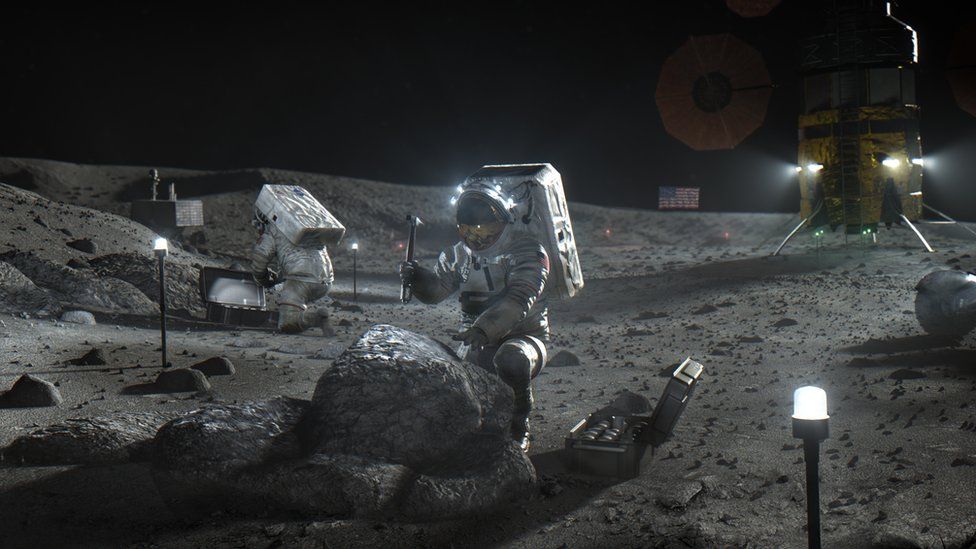Water on the Moon could sustain a lunar base
- Published

Having dropped tantalising hints days ago about an "exciting new discovery about the Moon", the US space agency has revealed conclusive evidence of water on our only natural satellite.
This "unambiguous detection of molecular water" will boost Nasa's hopes of establishing a lunar base.
The aim is to sustain that base by tapping into the Moon's natural resources.
The findings have been published as two papers in the journal Nature Astronomy.
Unlike previous detections of water in permanently shadowed parts of lunar craters, scientists have now detected the molecule in sunlit regions of the Moon's surface.
Speaking during a virtual teleconference, co-author Casey Honniball, postdoctoral fellow at Nasa's Goddard Space Flight Center in Maryland, said: "The amount of water is roughly equivalent to a 12-ounce bottle of water in a cubic metre of lunar soil."
Her Nasa colleague Jacob Bleacher, from the agency's human exploration directorate, said researchers still needed to understand the nature of the watery deposits. This would help them determine how accessible they would be for future lunar explorers to use.
And while there have previously been signs of water on the lunar surface, these new discoveries suggest it is more abundant than previously thought. "It gives us more options for potential water sources on the Moon," said Hannah Sargeant, a planetary scientist from the Open University in Milton Keynes, told BBC News.
Nasa has revealed conclusive evidence of water on the Moon
"Where to put a Moon base is largely focused on where the water is."
The US space agency has said it will send the first woman and next man to the lunar surface in 2024 to prepare for the "next giant leap" - human exploration of Mars as early as the 2030s.
Dr Sargeant explained that this meant developing "a more sustainable way of doing space exploration".
"Part of that is using these local resources - especially water," she told BBC News.
How did scientists find this lunar water?
The first of these new discoveries was made from an airborne infrared telescope known as Sofia. This observatory, on board a modified Boeing 747, flies above much of Earth's atmosphere, giving a largely unobstructed view of the Solar System.
Using this infrared telescope, researchers picked up the "signature" colour of water molecules.
The researchers think it is stored in bubbles of lunar glass or between grains on the surface that protect it from the harsh environment.
In the other study, scientists looked for permanently shadowed areas - known as cold traps - where water could be captured and remain permanently. They found these cold traps at both poles and concluded that "approximately 40,000 kilometres squared of the lunar surface has the capacity to trap water".
What does this discovery mean?
Dr Sargeant said this could "broaden the list of places where we might want to build a base".
There are quite a few one-off missions to the Moon's polar regions coming up in the next few years. But in the longer term, there are plans to build a permanent habitation on the lunar surface,
"This could have some influence. It gives us some time to do some investigation," said the Open University researcher.
"It doesn't give us much time because we're already working on Moon base ideas and where we're going to go, but it's more promising.
"We were going to go to the Moon anyway. But this gives us more options and makes it an even more exciting place to go."
Experts say that water-ice could form the basis of a future lunar economy, once we've figured out how to extract it.
It would be much cheaper to make rocket fuel on the Moon than send it from Earth. So when future lunar explorers want to return to Earth, or travel on to other destinations, they could turn the water into the hydrogen and oxygen commonly used to power space vehicles.
Re-fuelling at the Moon could therefore bring down the cost of space travel and make a lunar base more affordable.
Follow Victoria on Twitter.
- Published22 September 2020
- Published8 May 2020